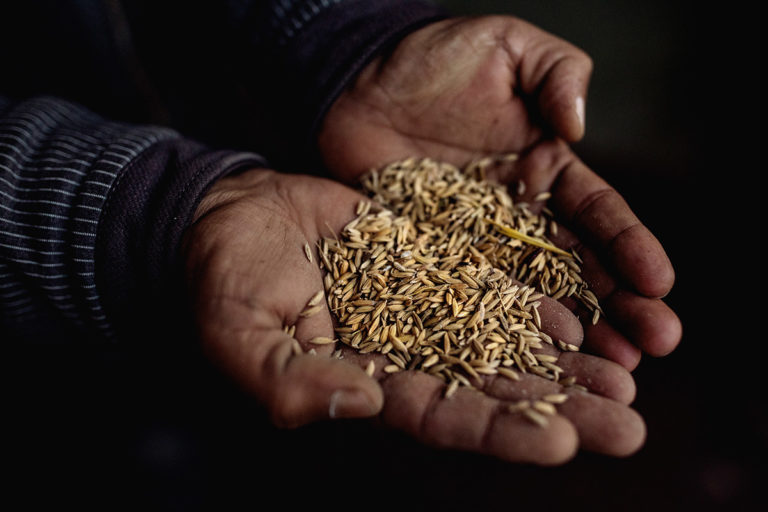- Some farmers in Nepal are slowly returning to organic farming methods using native crop varieties, after more than a decade of hybrid seeds being available in the market.
- Critics say hybrids require more intensive use of chemical fertilizers and pesticides, and produce fruit and vegetables with less flavor than native or openly pollinated varieties.
- The government is also supporting the push for organic, including through subsidies for farmers, but acknowledges it’s difficult to change minds.
- Many farmers continue to prefer hybrids, despite the associated problems, because of their higher yields, which mean more income.
KAVREPALANCHOK, Nepal — Ram Shrestha is spraying pesticide on his potato plants next to a paved road. The cracked earth seems lifeless here in this part of Kavrepalanchok district, a couple of hours’ drive east of Kathmandu, Nepal’s capital.
Since 2004, farmers here and elsewhere in Nepal have sown hybrid seeds distributed by Monsanto, and increasingly from producers in neighboring India and China. They’ve also had to use more chemical fertilizers and pesticides in the process — something that critics of hybrid and genetically modified seeds, also known as GMO seeds, say is common where these varieties of crops are cultivated.
“I know it’s bad to use it,” Ram says, “but if I don’t spray, there won’t be any potatoes at all.”

This preference for hybrids may be slowly changing among Nepali farmers. An outcry in 2011 over a plan to subsidize distribution of Monsanto hybrid
This preference for hybrids may be slowly changing among Nepali farmers. An outcry in 2011 over a plan to subsidize distribution of Monsanto hybrid seeds in three districts, including Kavrepalanchok, or Kavre, as it’s more commonly known, has seen the company lose ground to competitors. At the same time, more Nepali farmers and consumers are realizing the importance of growing organic crops — although they haven’t abandoned hybrids altogether.
In the village of Khok Besi, in Kavre, fields of cauliflower cover the fertile soil. Karunga Tamang, a farmer, says shoppers at the local market often ask if the cauliflowers she sells are organic. It’s complicated: Even though Karunga and most of the area’s farmers have abandoned chemical pesticides and fertilizers for organic alternatives, they still use hybrid seeds.
“The local cauliflower seeds would have taken five to seven months to harvest. The hybrids take half that time, as well as giving much bigger cauliflowers,” she says.
Nobody in the area grows local cauliflower seeds anymore. And cauliflower isn’t the only crop where native varieties have been replaced by hybrids. Up until the 1990s, Nepal was a seed-exporting country, with its farmers relying on a wealth of ancient native seeds, including 4,300 varieties of rice alone. Many of these varieties have since been lost, and today Nepal imports 90% of its vegetable seeds, including about one-third of maize seeds and 15% of rice seeds according to an article in the Kathmandu Post.
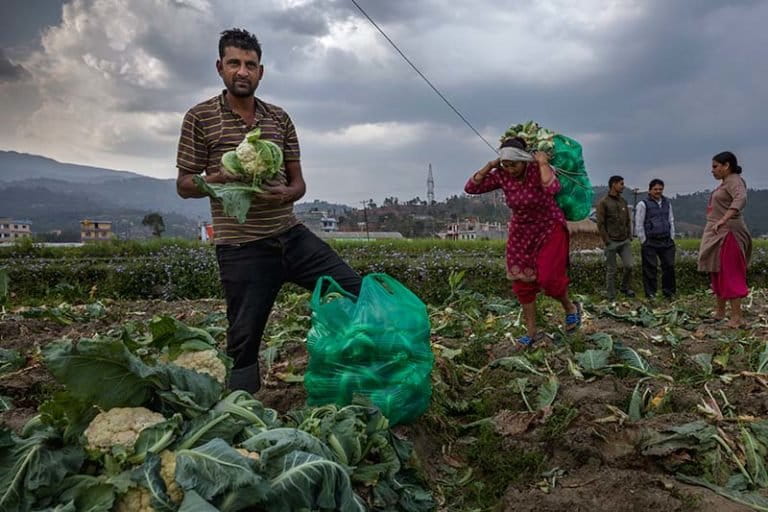
The hybrid promise
Hybrids first arrived in Nepal in the early 1980s, when the country’s population was half of what it is today. Advocates of hybrids and GMO (the latter is prohibited in Nepal) say the higher yields are crucial in ensuring food supply for a growing population while minimizing pressure on land resources for agriculture. In Nepal, the population is approaching 30 million and growing by nearly 2% annually. This, combined with urbanization and soaring land prices, adds up to farmers turning to hybrid seeds to maximize their output.
But there have been drawbacks associated with the trend that has threatened food security. Nepal has already experienced several incidents of massive crop failure from disease, often involving hybrid seeds from Indian and Chinese companies. Many farmers have also become reliant on buying hybrid seeds from foreign companies; with hybrids, unlike with heirloom or openly pollinated crops, sowing the seeds from a hybrid harvest won’t result in the same traits as in the first generation, hence the need to buy new seeds each season.
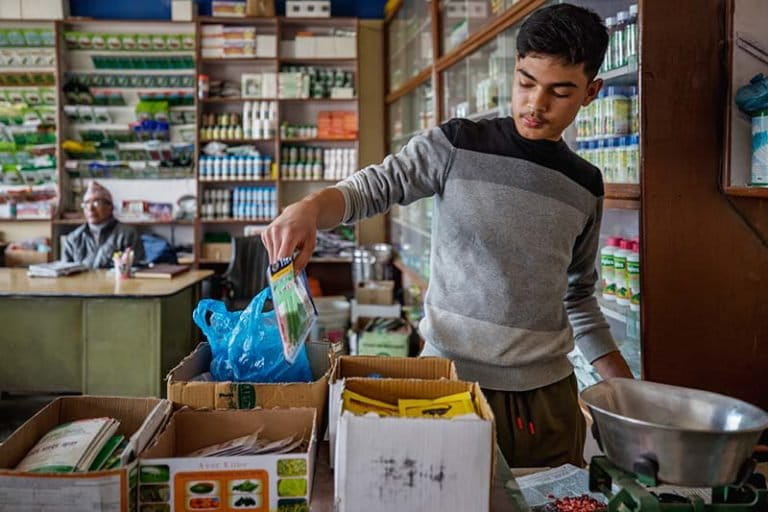
going organic
Change is coming slowly. Cauliflower farmer Karunga Tamang also grows tomatoes from local seeds. She uses droppings from her cows as fertilizer, as well as the fungi Trichoderma as a biocontrol agent to fight root and leaf disease.
At the market, many locals say the tomatoes taste and smell like, well, tomatoes. That’s often not the case with hybrids, which can lose flavor and aroma when engineered for size, color and other traits. And it’s not just the farmers and consumers who are taking notice.
At the Kavre government offices, head of agriculture Rameshor Shrestha says the district is investing in programs to convince farmers to grow seeds from openly pollinated varieties and to use organic fertilizers and pesticides.
“We want to subsidize farmers who grow local seeds since those harvests are naturally smaller than harvests from hybrid seeds,” he says. “By doing so, we hope that more farmers become interested in organic farming.”
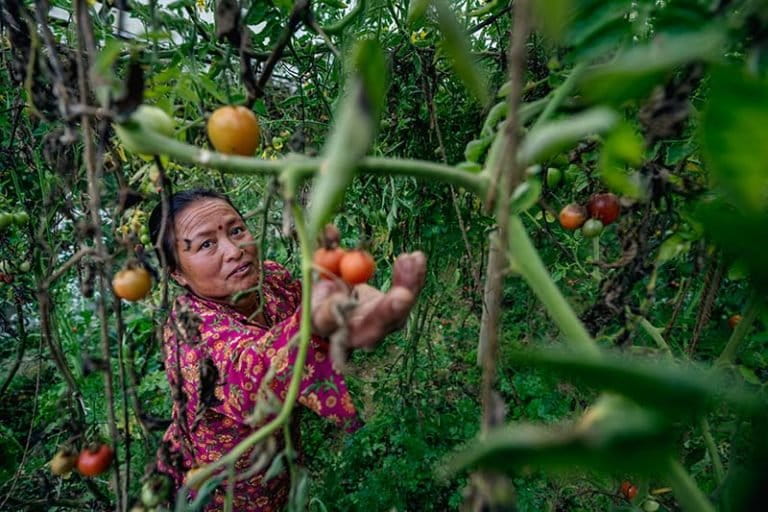
But he says it’s an uphill struggle when farmers prefer hybrids, particularly the Chinese rice varieties and Indian maize and vegetable hybrids. He adds that their cultivation over the years has stripped the soil of its nutrients and made the crops susceptible to disease.
“We’ve had hybrids for 10 years, and now people are becoming aware of the issues, but it’s a bit too late,” Rameshor tells Mongabay about practices in Kavre.
Compounding the degradation of fertile farmland is the issue of climate change, where he says the trends are clear – and worrying.
“We see a pattern for the last decade, where a change to hotter temperatures is a big problem for Nepal as an agricultural country,” he says.
Rameshor says farmers will have to adapt by growing climate-resistant crops and farming at higher elevations. Collecting rainwater and pumping downriver for irrigation are two other measures already being practiced by some farmers.
“It’s not easy to address the farmers with these issues but we need to do so to keep in pace with the changes,” Rameshor says.
At a seed shop in Kavre’s Panchkhal municipality, owner Govinda Sapkota says most buyers ask for hybrid seeds “because they are more productive.”
But he says there’s a growing number going against the grain. Among them is farmer Narayan Dhakal.
“Most people around here don’t care about the environment,” Narayan says. “But some are concerned about the nutrients in the soil, so many have started with composting, and NGOs are working directly with minimizing soil destruction.”
Narayan says he uses fewer pesticides than he used to, and other farmers in the area are doing the same. “We realize that selling organic vegetables at the market brings in more money than we would get for conventional vegetables.”
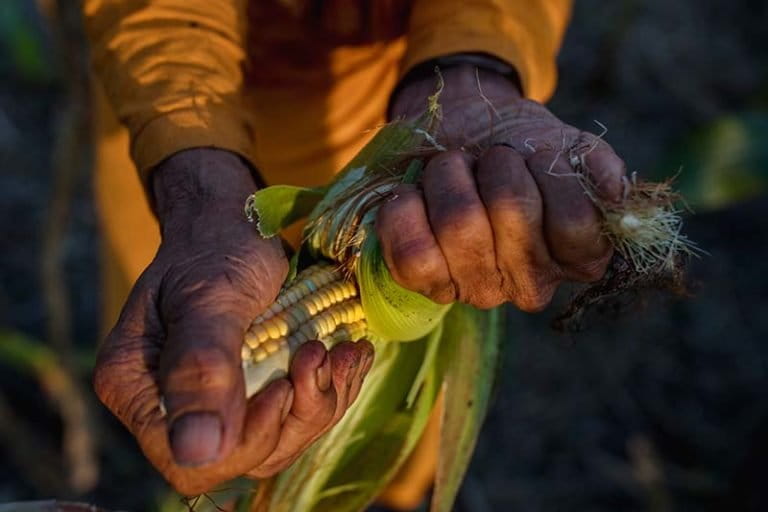
Backlash against imported hybrid seed program
Monsanto had been quietly selling hybrid seeds in Nepal since 2004. In 2011, the company and USAID announced a program to subsidize seed distribution to farmers in Kavre, Chitwan and Nawalparasi districts. The announcement caught many by surprise, including the Nepali government, with an agriculture ministry official saying they had expected the hybrid seeds for the program would be developed domestically, not imported by Monsanto. Parliament held hearings on the matter, and activists also mounted a coordinated opposition to the plan, under the banner “Stop Monsanto in Nepal.” The program never got off the ground.
Nishan Paudel worked for Monsanto at the time in Chitwan district. He says the company sent out teams to engage with farmers. “They gave suggestions on which pesticides and fertilizers to use to get a high outcome,” Nishan says.
Today, he says, many farmers realize that hybrids more frequently entail pest problems. But at the same time, they depend on the higher yields. “Most farmers don’t want hybrids, but they need the income that comes with them,” Nishan says.
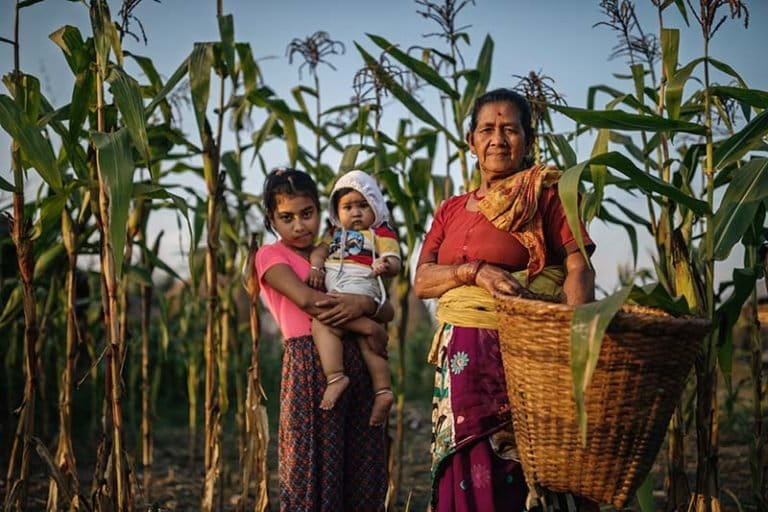
A back-to-basics movement
Hem Subedi lives just outside Chitwan National Park, where he works as a nature guide taking tourists around the park famed for its tigers and rhinos. At home, he’s kept bees in his garden for the past 14 years, and plans to expand to 70 hives with a total of about 70,000 bees.
The natural pollinators travel up to 6 kilometers (nearly 4 miles) into the adjacent forest and farmlands, and as they pollinate plants they also bring back pollen and nectar.
Hem harvests 20 kilograms (44 pounds) of honey per hive per season, which he sells to tourists as a side business. He also plans to open a homestay on his family’s land, where they’ll serve dishes made with organic vegetables from the farm that extends behind the house. “I grow peas and pumpkin from local seeds,” Hem says, pointing at rows of vegetables. “I just planted local corn and garlic.”
The family’s two water buffalo provide the dung that’s used as biofertilizer; Hem is vehemently against using chemical pesticides. “I use buffalo urine as biopesticide, where biopesticides won’t kill insects,” he says. “Ninety-eight percent of insects are beneficial to us. When we apply chemical pesticides, they kill everything!”
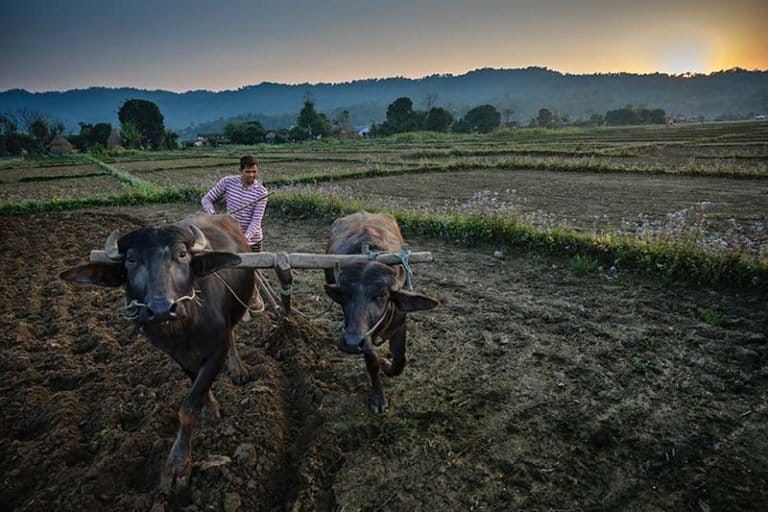
Chemical pesticides also take a toll on the farmers, with Hem telling of locals suffering from eyes problems, skin rashes and headaches when working in the fields. Hem was part of the movement against the Monsanto program in 2011, standing outside the local government offices with “Stop Monsanto” posters.
“The local [crop] diversity vanishes when companies bring in hybrids and GMO, and start to cross-pollinate,” he says, adding that of Nepal’s 4,300 rice varieties 50 years ago, there are only 150 left.
As a beekeeper Hem draws much attention from his neighbors and other locals. He holds workshops for villagers interested in taking up beekeeping or farming organically.
“I organize courses for farmers who want to change their habits,” Hem says. “I tell people which herb species to collect in the jungle, to use as biopesticides in their garden.”
This back-to-basics movement is taking root in other villages around Chitwan. In the village of Madi, Thai Bote, 75, says he remembers when Monsanto came to the village, followed by Indian hybrid seeds. The village’s farmers grew maize, rice, cumin and beans from the hybrid seeds, and used chemical pesticides and fertilizers to get the most out of them.
“We had full stomachs, but no energy, and the crops didn’t taste of anything, which also made them difficult to sell at the market,” Thai says. “We slowly got back to the old system, because most people think that local seeds taste much better and are more nutritious.”
Banner image caption: Farmers in Nepal are returning to local seeds citing crops from hybrid seeds being hard to store since they are much less resilient to pests and decompose faster. Image by Jonas Gratzer for Mongabay.

